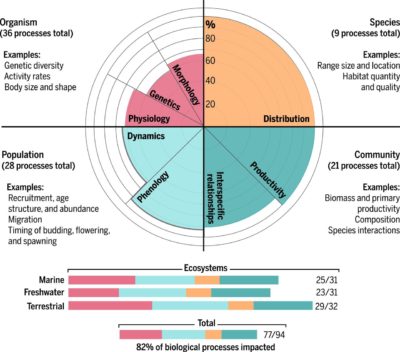Eric passed his preliminary exam! Making it over this hurdle is always worth celebrating – congratulations, Ph.D. candidate, Eric Moore!
Page 2 of 4
Cleo and Bryce were hard at work for the month of September out in the North Atlantic. Cleo continues collecting data on volatile organic compounds that are cycled among members of the marine microbial community. If cycling becomes uncoupled, these VOCs can be released into the atmosphere with wide ranging climate effects. Bryce was responsible for measuring net primary production, so he spent a lot of time in the rad van (where he can use radiolabeled isotopes). Once in awhile he was free to enjoy the vast sea. The last of the four cruises is coming up quickly in March, 2018…

Congratulations to post doc Cleo Davie-Marin who received an award to study the volatile organic carbon metabolome. This award will help her to develop a new incubation technique to investigate VOC “fingerprints” produced by the abundant cyanobacterium, Synechococcus sp. This work builds on the momentum developed through her mentorship of undergraduate researcher, Duncan Ocel. Duncan and Cleo are an adventurous team, both scaling rocks and seeking other adventures whenever not in the lab, where they are also exploring new territory.
Our newest lab paper was published today. This manuscript describes two important discoveries in diatom lifecycles.
PLoS ONE 12(7): e0181098. https://doi.org/10.1371/journal.pone.0181098
1.) Thalassiosira pseudonana IS a sexual diatom species
2.) Ammonium induces sex in T. pseudonana and at least two other centric diatoms.
To prove these discoveries, Eric Moore with help from Briana Bullington carried out a number of carefully controlled culturing experiments, imaged all of the cell morphologies in the lifecycle, and identified >1,200 genes that were differentially expressed under conditions of ammonium induced cell differentiation. Some of these genes are involved in meiosis, flagellar synthesis, and sex differentiation.
Thanks to all of our co-authors, Alex Weisberg, Jeff Chang, and Yuan Jiang for their help with gene expression analysis and statistical testing.
Nobody had ever seen the model centric diatom, Thalassiosira pseudonana, undergo sexual reproduction. Grad student, Eric Moore, documented the sexual stages and showed upregulation of genes involved in meiosis and flagellar synthesis. Moreover, he figured out what triggers these diatoms and other centric diatoms to shift into the sexual cycle resulting in cell enlargement. Read about it here on BioRxiv.
doi: https://doi.org/10.1101/144667

 Our most recent paper on VOC cycling in the surface ocean was just published in Limnology and Oceanography. Phytoplankton produce different profiles of VOCs depending on species and some bacterioplankton, including the ubiquitous and abundant SAR11 bacteria consume these compounds. We designed new incubation chambers and attached these chambers to a PTR-MS to make real time measurements of VOC production and consumption . This work was a collaborative effort with atmospheric physicists at NOAA. Halsey et al. 2017 doi: 10.1002/lno.10596
Our most recent paper on VOC cycling in the surface ocean was just published in Limnology and Oceanography. Phytoplankton produce different profiles of VOCs depending on species and some bacterioplankton, including the ubiquitous and abundant SAR11 bacteria consume these compounds. We designed new incubation chambers and attached these chambers to a PTR-MS to make real time measurements of VOC production and consumption . This work was a collaborative effort with atmospheric physicists at NOAA. Halsey et al. 2017 doi: 10.1002/lno.10596
Congratulations to Kelsey!! She defended her MS on December 7, and a few weeks later packed her bags for sunny UCSB. Kelsey will be a culturing technician in Alyson Santoro’s lab. Kelsey was energetic, creative, and dedicated…qualities that are essential for graduate school. We will sure miss her humor…and look forward to hearing about her new adventures down south.
Duncan Ocel received the OSU Honors College DeLoach Work Scholarship to pursue investigations of VOCs produced by marine cyanobacteria. This scholarship will allow him to spend more hours in the lab – and we are happy with that outcome!
New review in Science today highlighting the environmental impacts of climate change. Is everyone listening?
From the abstract:
“Understanding shifts in ecological processes can guide human adaptation strategies. In addition to reducing greenhouse gases, climate action and policy must therefore focus equally on strategies that safeguard biodiversity and ecosystems.”
Climate change impacts on ecological processes in marine, freshwater, and terrestrial ecosystems
Impacts can be measured on multiple processes at different levels of biological organization within ecosystems. In total, 82% of 94 ecological processes show evidence of being affected by climate change. Within levels of organization, the percentage of processes impacted varies from 60% for genetics to 100% for species distribution.
Way to go, Briana! Briana helped generate some very exciting data for an upcoming paper during her undergraduate and post-baccalaureate research in our lab. She will be working at OSU’s Veterinary Diagnostics Lab as a medical technician.
